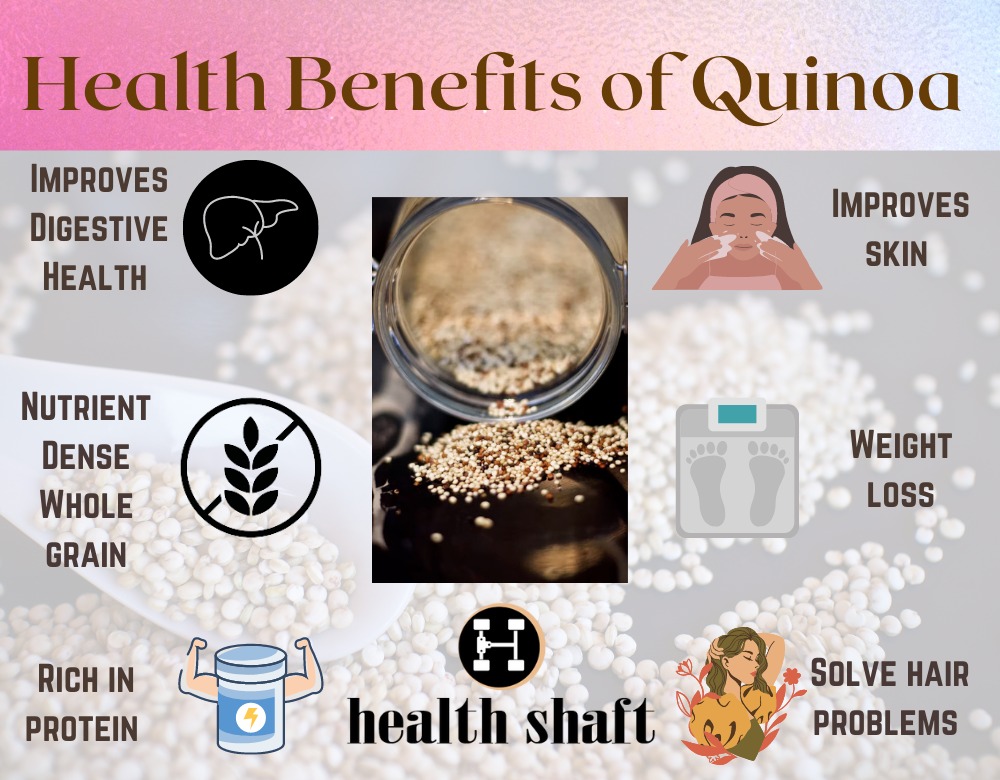Table of Contents
What is quinoa ?
Quinoa is pronounced as “keen-wah”, “kinwa ” or “kinuwa ”.
Quinoa is an amaranth-family flowering plant. Quinoa is a centuries-old South American grain that has been mostly overlooked. Surprisingly, the rest of the world just lately recognised it and acclaimed it as a “superfood” due to its high nutritional value.
Quinoa has a nutty taste and a crunchy texture. It’s also gluten-free, so it’s suitable for those who are gluten or wheat intolerant.
Quinoa seeds are flat, oval, and pale yellow in appearance, however they can also be pink or black. It has a range of flavours, from bitter to sweet.
Quinoa comes in over 120 different variations. The mildest quinoa kinds are white and yellow, so they’re ideal to start with. Red and black quinoa have slightly stronger, earthier tastes than lighter coloured quinoa, and they keep their form better.
Nutritional Facts of Quinoa
Quinoa is a extraordinary source of Manganese,Phosphorus,Magnesium,Folate,Thiamin (Vitamin B1).
Cooked quinoa has 222 calories per cup (185 grammes).
Quinoa has 71.6 percent water, 21.3 percent carbs, 4.4 percent protein, and 1.92 percent fat when cooked.
For 3.5 ounces (100 grammes) of cooked quinoa, the nutrition information are as follows :
120 calories
72 percent water
4.4 grammes of protein
0.9 gramme sugar
2.8 grammes of fibre
1.9 grammes of fat
21.3 grammes of carbohydrates
Quinoa does not contain gluten. It has been chosen as an experimental crop in NASA’s Controlled Ecological Life Support System for long-duration human inhabited space voyages because of its high protein content, simplicity of usage, variety in preparation, and potential for enhanced yields in controlled conditions.
Health Benefits of Quinoa
Quinoa’s popularity has exploded in recent decades, thanks to a surge in demand for easy-to-grow, healthful, gluten-free grain alternatives.
Quinoa is not only nutrient-dense, but it may also provide health advantages.
Quinoa is a bunch of Nutritents
Quinoa contains a variety of essential elements, including folate, magnesium, zinc, and iron.
It’s also high in fibre and protein, two nutrients that contribute to a feeling of fullness. Quinoa is loaded vitamins , proteins , fiber , folate , copper , iron , potaasium , phosphorus , manganese , magnesium .
Plant chemicals that are antioxidants and anti-inflammatory.
Quercetin and kaempferol are two flavonoid plant components that have been extensively investigated. Quinoa’s major flavonoids are as follows.
In the body, quercetin and kaempferol have anti-inflammatory properties and operate as antioxidants, which means they help protect cells from harm caused by unstable chemicals known as free radicals.
You may dramatically boost your total intake of these and other antioxidant chemicals by incorporating healthful foods like quinoa in your diet.
Fiber content is higher than that of several cereals.
Quinoa is abundant in fibre, an essential component for good health. Including more fiber-rich foods in your diet can assist with intestinal health, weight management, and other issues. A 1-cup (195-gram) meal of cooked brown rice, for example, has 3.51 grammes of fibre, compared to 1.67 grammes for the same serving size of quinoa.
By fostering regular bowel movements and feeding good microorganisms in your stomach, fiber-rich foods like quinoa can help maintain your digestive health.
Gluten-free and ideal for gluten-intolerant persons.
Quinoa (pronounced keen-wah) is gluten-free and a fantastic gluten-free grain substitute. It is a nutrient-dense whole grain that has more antioxidants than other gluten-free grains. It’s also one of the few plant meals that has all nine essential protein acids. That is, it has all nine amino acids required to be classified as a protein.
A decent protein source
Quinoa has a high protein content, with 8 grammes per cooked cup (185 grammes). Quinoa is a complete protein that includes all nine necessary amino acids. It’s one of the few complete proteins made from plants. Quinoa, on the other hand, is low in protein. Cooked quinoa has 8 grammes of protein per cup. As a result, quinoa has a moderate amount of high-quality protein.
However, because it contains low levels of some amino acids, such as lysine, scientists contend that quinoa should not be called a complete protein.
Important vitamins and minerals are abundant.
Antinutrients found in quinoa include:Phytic acid, saponins, tannins
It also has a low phytic acid content. This molecule, which may be found in a variety of grains and vegetables, binds to minerals in meals and inhibits them from being absorbed. Quinoa is a good source of readily absorbed nutrients since it is low in phytic acid.
Quinoa assist you in losing weight.
Quinoa is a great way to lose weight. Quinoa is high in insoluble fibre, which keeps you fuller for longer and helps you lose weight. Quinoa’s high protein and healthy fat content help to speed your metabolism and keep you feeling energised. Protein promotes fullness and controls cravings by regulating the hunger hormone ghrelin. This keeps you fuller for longer and helps you overeat less. Quinoa is a good source of fibre in addition to protein. Fibre takes a long time to break down and digest, so it keeps you full and avoids overeating.
Benefits for skin
- Skin Tone is Improved.
- The Anti-Aging Secret
- Skin that has been damaged is repaired.
- By brightening the skin, it helps to reduce brown spots.
- Acne treatment
Benefits for hair
- Hair growth is aided by this product.
- Dandruff is reduced.
- Hair is conditioned.
- It aids in the detangling of frizzy hair.
- Ends that have been split are sealed.
- Pollution protection for your hair.
- Hair Follicles are strengthened.
Benefits of quinoa over rice
Quinoa has a lower glycemic index than white rice, thus it doesn’t cause a rapid rise in blood sugar levels.
White rice has more calories and carbs than quinoa.
Quinoa is a healthy choice because of its greater protein and fibre content, as well as the fact that it fills you up faster, allowing you to eat less portions.
Unlike rice, quinoa lowers triglyceride levels in the blood after a meal.
Quinoa and rice also have the virtue of being naturally gluten-free, making them wonderful grain options for anybody who has a gluten allergy or just wants to eliminate gluten from their diet.
Drawbacks of Quinoa
- Nausea, diarrhoea, vomiting, hives, eczema, stomach irritation, and itching are all possible adverse effects of the supplement.
- Quinoa consumption can trigger allergic reactions or inflammation in the digestive tract, skin, and lungs.
- Quinoa produces phytic acid, which is linked to various minerals and can prevent the seeds from being absorbed in the intestines.
- Shortness of breath, frequent coughing, and chest tightness may occur if you have asthma and use quinoa supplements.
- Because it has an effect on the unborn child, it is not suggested for pregnant or nursing women.
- The seeds might produce bloating and flatulence if consumed often.
- It includes oxalates, which are produced when quinoa seeds are overcooked. They can inhibit the absorption of minerals like calcium and magnesium by the body. Kidney stone development can also be caused by oxalate.
People For ask
Is it ok to eat quinoa everyday ?
It is okay to have Quinoa in proper way .Quinoa is a seed from a plant that may be eaten. According to a Harvard Public School of Health research, eating a bowl of quinoa every day can lower the risk of dying young from cancer, heart disease, respiratory disorders, diabetes, and other chronic diseases by 17%.
Why is quinoa superfood ?
Quinoa is abundant in fibre, as well as a number of vitamins and minerals that are often lacking in most people’s diets. Quinoa can help you satisfy your magnesium, potassium, iron, fibre, and folate needs, which are especially essential during pregnancy because of the function it plays in foetal growth and development.
Does quinoa make you fat ?
Quinoa is not a fatty food in and of itself. Quinoa has 368 calories and 64 grammes of carbs per 100 grammes. The issue is the amount of carbohydrates in quinoa, which is especially problematic if you’re trying to lose weight because that 64 grammes of carbs alone contain 256 calories.
Is quinoa better than rice ?
In terms of calories and fibre, quinoa and rice are equivalent. Both are nutritious nutrients that may be used to fill out a well-balanced diet, but quinoa has the upper hand. Brown rice only includes a few of the necessary amino acids, but soy is a complete protein.
Is quinoa beneficial to intestinal health?
In conclusion, quinoa consumption reduced gut microbial dysbiosis and eased clinical symptoms generated by DSS, suggesting that quinoa may be used as a dietary therapy to promote intestinal health.
Conclusion
Quinoa is gluten-free by nature and is typically well accepted by persons who are gluten-intolerant; however, certain items may be cross-contaminated, so make sure you buy certified gluten-free. Quinoa is an excellent carbohydrate source to add in your diet.
Whether you have celiac disease, gradually increase your quinoa consumption to determine if you can handle it without causing symptoms.
Quinoa is a flexible, tasty, and simple-to-prepare complement to most people’s healthy diets, whether gluten-free or not.
It’s technically a seed and, together with amaranth and buckwheat, belongs to a tiny group of grains known as pseudocereals.
Because it’s high in fibre, minerals, antioxidants, and protein, it’s a wise carbohydrate option. It’s also gluten-free, tasty, adaptable, and super simple to make.

